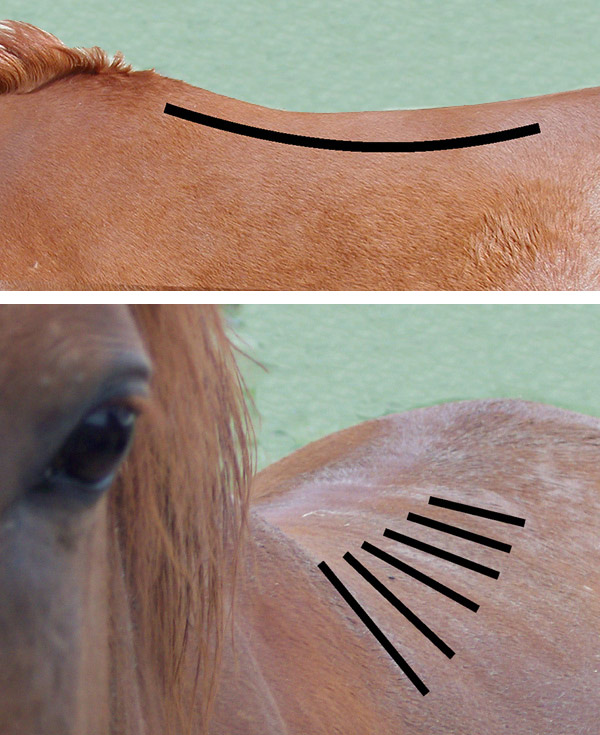There was a time when saddle fit didn’t matter. Whoever that brave soul was who first decided to climb on a horse’s back probably impressed all of his friends and neighbors by how much further he could go and how quickly he could get there. But very soon he found that for long distances that it wasn’t very comfortable for either him or the horse. While bareback riding can be a great tool for developing rider balance, all of the rider’s weight is concentrated in a very small area of the horse’s back. The main job of a saddle is to spread the rider’s weight out over the length of the ribcage which lowers the pounds per square inch to an acceptable level for the horse. The other thing a saddle must do is to keep any pressure off of the horse’s spine.
While I will be referring to the Western tree, the basic concepts apply to the English saddle as well but instead of using the bars of the Western tree to spread out the rider’s weight, the English saddle uses panels stuffed with wool or foam.
Four things to keep in mind are:
- the heavier the rider
- the more often they ride
- the longer they ride
- the harder they ride
the more critical it is to have a saddle that fits. A one hundred and ten pound gal who rides an hour once a week and only walks her horse can get away with a terrible fitting saddle and possibly never see a problem. A two hundred pound guy who rides twenty hours a week and does a lot of cantering and trotting does not have much room for error when it comes to a good fit.
 Two dimensions on the horse or mule’s back must be addressed for proper saddle fit. First, the front to back curvature of the saddle tree, referred to as ‘rock’ or ‘rocker’, must match that of the ribcage. Secondly, the change in angle of the bars from the front of the tree to the back, referred to as the’ twist’, must also match the ribcage. If you look at the bottom of a tree you will see that the angle of the bars are steeper in the front and gradually flatten out towards the back. Too much or too little twist can cause problems wherever it doesn’t match the horse or mule’s ribcage.
Two dimensions on the horse or mule’s back must be addressed for proper saddle fit. First, the front to back curvature of the saddle tree, referred to as ‘rock’ or ‘rocker’, must match that of the ribcage. Secondly, the change in angle of the bars from the front of the tree to the back, referred to as the’ twist’, must also match the ribcage. If you look at the bottom of a tree you will see that the angle of the bars are steeper in the front and gradually flatten out towards the back. Too much or too little twist can cause problems wherever it doesn’t match the horse or mule’s ribcage.
When considering saddle fit you would like to see maximum contact in the middle of the saddle with contact tapering off at the front and rear of the bars. If the front of the bars don’t have enough ‘flare’ in them, there won’t be enough room for the shoulder to operate comfortably or for the horse to move his neck laterally. In the rear of the bars there must be enough flare for the horse’s hips to alternately rise and fall.
Through the years the bars of the saddle tree have been loosely classified by various names. Some of the more popular are semi-Quarter Horse, Quarter Horse, and full-Quarter Horse. If we divide up different horse’s ribcages into narrow, medium and wide classifications, trees with Semi-Quarter Horse bars would be a starting point for your narrower horses, Quarter Horse bars would be for the medium range and full-Quarter Horse bars for your wider horses or mules. That being said, there is absolutely no standard between tree manufacturers. If we took three Quarter Horse barred trees from three different tree manufacturers there would be differences not only in gullet height and width but also in the rock and twist. That’s why one saddle maker’s full Quarter Horse tree might work fine and then you switch to another brand and you end up with a sore horse.
Being a custom saddler, one of the things we hear all the time is “I have a hard to fit horse.” Generally, these people have tried three to five different saddles from different manufacturers and haven’t had any luck with any of them. Production line or tack shop type saddles are built on averages. “The “average” narrow horse or mule’s back needs a gullet that is so wide and so high and needs this much rock and this much twist.” But what happens when they have what I call a combination back? Maybe they are narrow in the front but the twist flattens out more than the “average” narrow back. Horses and mules are just like people. If we take ten men who are 6’ tall and weigh 180 lbs, five of them would look fine in an off the rack suit. The other five would have varying levels of success because they aren’t “average” enough. A couple of them might have to have a tailored suit custom made for them.
Although I have only scratched the surface of the topic I hope that I have given you enough information so that you can assess your current fit or be able to confidently talk to a tack shop sales person or custom saddler and be able to get a saddle that will keep your horse or mule comfortable.
